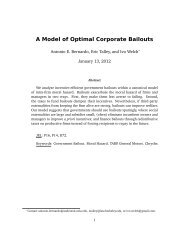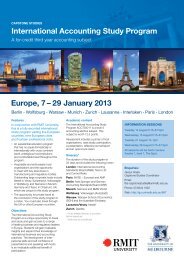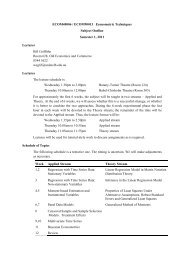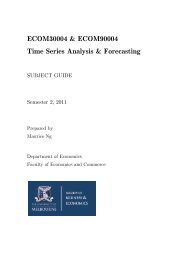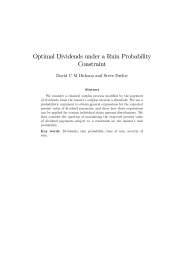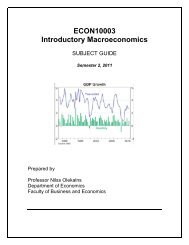Bayesian Inference in the Seemingly Unrelated Regressions Model
Bayesian Inference in the Seemingly Unrelated Regressions Model
Bayesian Inference in the Seemingly Unrelated Regressions Model
Create successful ePaper yourself
Turn your PDF publications into a flip-book with our unique Google optimized e-Paper software.
12<br />
N<br />
N<br />
1 ˆ( ) 1<br />
1( ) 1 1( )<br />
ˆ( | )<br />
$ [ (<br />
− $ ) ]<br />
−<br />
T (<br />
− $<br />
∑ ∑ ′ ′<br />
T )<br />
N $ = 1 N $ = 1<br />
E β y = β = X Σ ⊗I X X Σ ⊗ I y =βˆ<br />
(28)<br />
and<br />
( )( )<br />
N<br />
N<br />
1 −1( $ ) −1 1 ˆ( $ ) ˆ ˆ( $ )<br />
∑ ′<br />
ˆ<br />
T ∑<br />
N $ = 1 N − $ = 1<br />
′<br />
Vˆ( β | y ) = [ X ( Σ ⊗ I ) X ] + β − β β − β<br />
1<br />
(29)<br />
Clearly, us<strong>in</strong>g <strong>the</strong> sample means and standard deviations from equations (24) and (25)<br />
is much easier than us<strong>in</strong>g <strong>the</strong> conditional quantities <strong>in</strong> equations (26) through (29).<br />
However, averag<strong>in</strong>g conditional moments generally leads to more efficient estimates.<br />
C. Estimat<strong>in</strong>g Probabilities<br />
Often, we are <strong>in</strong>terested <strong>in</strong> report<strong>in</strong>g <strong>the</strong> probability that β ik lies with a particular<br />
<strong>in</strong>terval or f<strong>in</strong>d<strong>in</strong>g an <strong>in</strong>terval with a pre-specified probability content. In sampl<strong>in</strong>g<br />
<strong>the</strong>ory <strong>in</strong>ference <strong>in</strong>tervals with 95% probability content are popular. An estimate of<br />
<strong>the</strong> probability that β ik lies <strong>in</strong> a particular <strong>in</strong>terval is given by <strong>the</strong> proportion of draws<br />
that lie with<strong>in</strong> that <strong>in</strong>terval. Alternatively, one can f<strong>in</strong>d conditional probabilities and<br />
average <strong>the</strong>m, along <strong>the</strong> l<strong>in</strong>es that <strong>the</strong> conditional means are averaged <strong>in</strong> equations<br />
(26) and (28). Us<strong>in</strong>g <strong>the</strong> conditional normal distribution as an example, we can<br />
estimate <strong>the</strong> probability that β ik lies <strong>in</strong> <strong>the</strong> <strong>in</strong>terval ( a , b)<br />
as<br />
N $ = 1<br />
( $ )<br />
( ik )<br />
1<br />
N<br />
Pa ˆ( < β < b) = P a< ( β | Σ ) < b<br />
ik<br />
∑<br />
(30)<br />
Order statistics can be used to obta<strong>in</strong> an <strong>in</strong>terval with a prespecified<br />
probability content. For example, for a 95% probability <strong>in</strong>terval for β ik<br />
<strong>the</strong> 0.025 and 0.975 empirical quantiles of <strong>the</strong> draws of <strong>the</strong> β ik .<br />
, we can take



